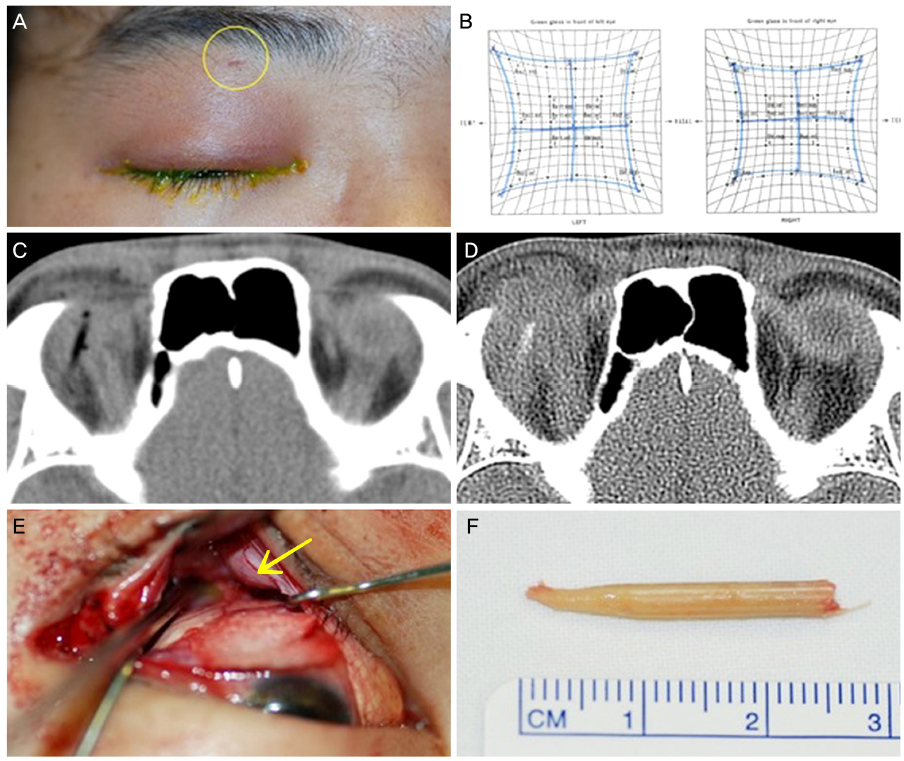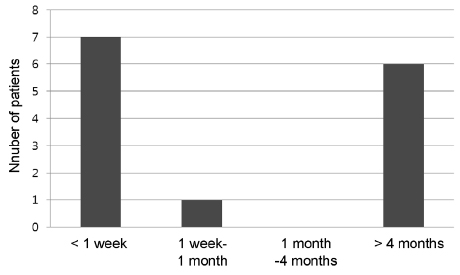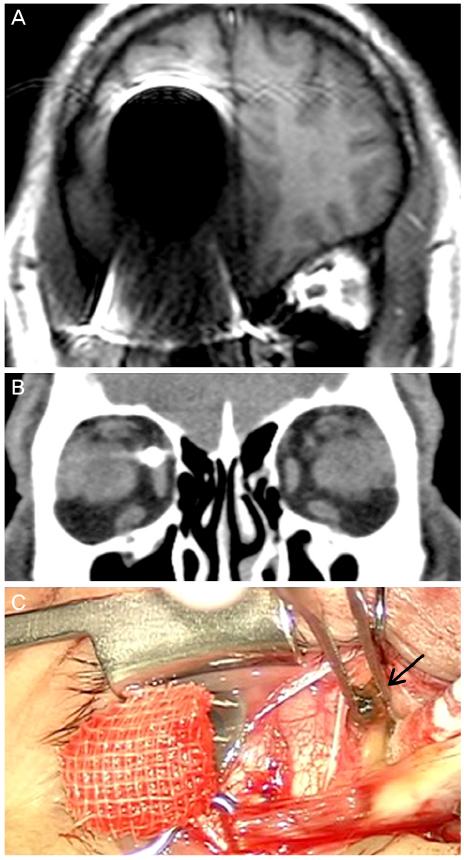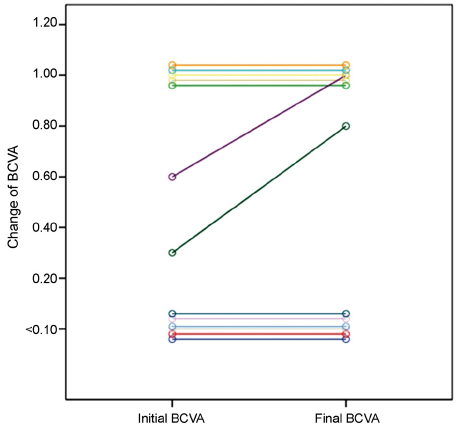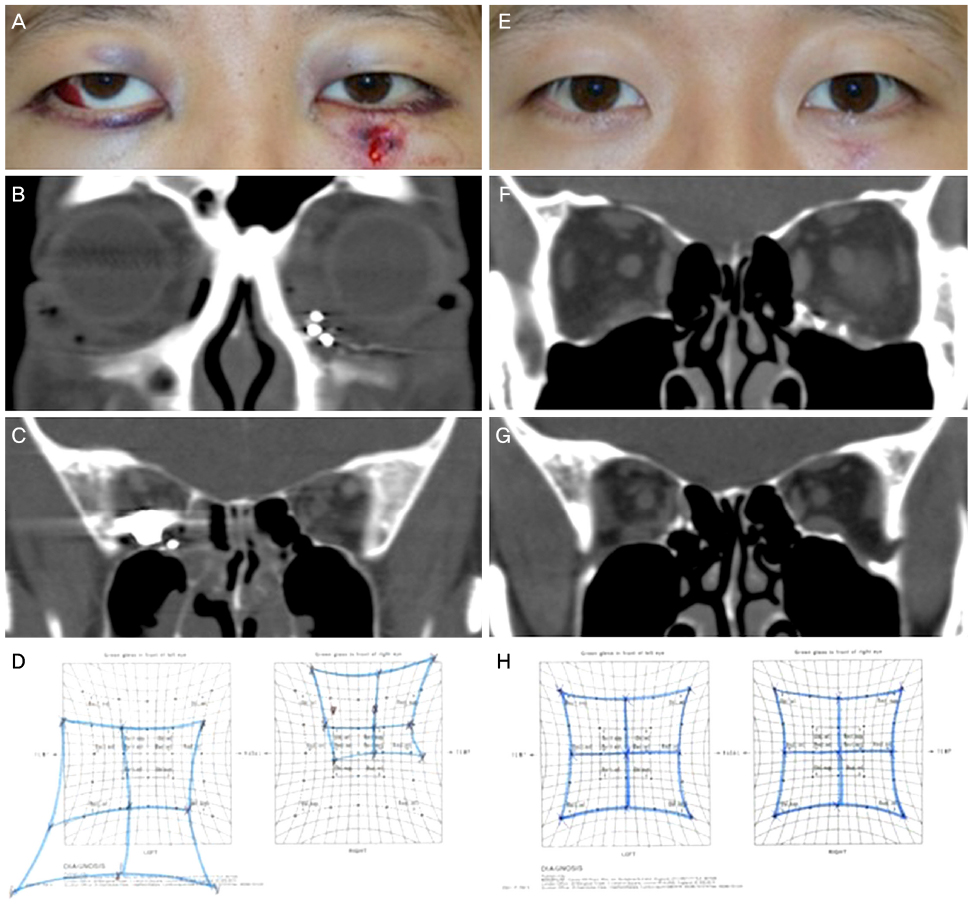J Korean Ophthalmol Soc.
2017 Mar;58(3):251-258. 10.3341/jkos.2017.58.3.251.
Clinical Characteristics of Intraorbital Foreign Bodies: Our Experience with 14 Cases
- Affiliations
-
- 1Department of Ophthalmology, Asan Medical Center, University of Ulsan College of Medicine, Seoul, Korea. lineblue@hanmail.net
- 2Department of Ophthalmology, Ilsan Paik Hospital, Inje University College of Medicine, Goyang, Korea.
- KMID: 2371904
- DOI: http://doi.org/10.3341/jkos.2017.58.3.251
Abstract
- PURPOSE
To evaluate the clinical characteristics of intraorbital foreign bodies as well as the treatment outcomes.
METHODS
This was a noncomparative interventional case series. Clinical data and radiographic images were gathered via retrospective chart reviews of 14 patients who underwent surgical removal of intraorbital foreign bodies by an oculoplastic surgeon at the Asan Medical Center, Seoul, Korea between July 2012 and November 2015.
RESULTS
The mean age of patients was 45.1 years and 13 patients (92.9%) were male. There were 9 metallic; 3 nonmetallic, inorganic; and 2 organic intraorbital foreign bodies in this series. The most common orbital complication was orbital wall fracture (8, 57.1%), and one patient had orbital cellulitis associated with a wooden foreign body. Six patients (42.9%) underwent surgical removal of foreign bodies in a delayed setting, and 4 of them needed surgery to allow for the brain magnetic resonance image tests to evaluate neurologic problems. There were 6 patients (42.9%) who had a postoperative corrected visual acuity worse than 20/200, and all of them had poor visual acuity at the time of injury due to associated eyeball or optic nerve injuries. Four patients (28.6%) had eyeball movement limitations from the initial trauma, but only 1 patient had persistent limitations postoperatively. There were no other complications associated with surgical removal.
CONCLUSIONS
The majority of patients with intraorbital foreign bodies were male who had periorbital traumas. The most common foreign body was metal, and orbital wall fractures were common. The poor visual prognosis was related to the eyeball or optic nerve injuries from the initial trauma. The urgent surgical removal should be performed for organic foreign bodies or associated orbital/ocular injuries. Metallic foreign bodies may also be considered for removal to allow for possible brain magnetic resonance image evaluations in the future.
Keyword
MeSH Terms
Figure
Reference
-
1. Kim HK, Chung WS. Clinical experience of intraorbital foreign body. J Korean Ophthalmol Soc. 1997; 38:177–184.2. Fulcher TP, McNab AA, Sullivan TJ. Clinical features and management of intraorbital foreign bodies. Ophthalmology. 2002; 109:494–500.3. Finkelstein M, Legmann A, Rubin PA. Projectile metallic foreign bodies in the orbit: a retrospective study of epidemiologic factors, management, and outcomes. Ophthalmology. 1997; 104:96–103.4. Nasr AM, Haik BG, Fleming JC, et al. Penetrating orbital injury with organic foreign bodies. Ophthalmology. 1999; 106:523–532.5. Cartwright MJ, Kurumety UR, Frueh BR. Intraorbital wood foreign body. Ophthal Plast Reconstr Surg. 1995; 11:44–48.6. Scharf J, Zonis S. Proptosis as presenting symptom of orbital foreign body. J Pediatr Ophthalmol. 1977; 14:176–177.7. Bullock JD, Warwar RE, Bartley GB, et al. Unusual orbital foreign bodies. Ophthal Plast Reconstr Surg. 1999; 15:44–51.8. Karcioglu ZA, Nasr AM. Diagnosis and management of orbital inflammation and infections secondary to foreign bodies: a clinical review. Orbit. 1998; 17:247–269.9. Macrae JA. Diagnosis and management of a wooden orbital foreign body: case report. Br J Ophthalmol. 1979; 63:848–851.10. Wang WJ, Li CX, Sebag J, Ni C. Orbital fistula. Causes and treatment of 20 cases. Arch Ophthalmol. 1983; 101:1721–1723.11. Charteris DG. Posterior penetrating injury of the orbit with retained foreign body. Br J Ophthalmol. 1988; 72:432–433.12. Pinto A, Brunese L, Daniele S, et al. Role of computed tomography in the assessment of intraorbital foreign bodies. Semin Ultrasound CT MR. 2012; 33:392–395.13. Howe L, Jones NS. Guidelines for the management of periorbital cellulitis/abscess. Clin Otolaryngol Allied Sci. 2004; 29:725–728.14. Michon J, Liu D. Intraorbital foreign bodies. Semin Ophthalmol. 1994; 9:193–199.15. Kim ST, Kim DH. A case of intraorbital foreign body after gunshot wounds. J Korean Ophthalmol Soc. 2009; 50:649–655.16. Lim JH, Kwak MS. Case report of retained intraorbital metallic foreign body removal. J Korean Ophthalmol Soc. 1999; 40:1127–1132.17. Ho VH, Wilson MW, Fleming JC, Haik BG. Retained intraorbital metallic foreign bodies. Ophthal Plast Reconstr Surg. 2004; 20:232–236.18. Roden D, Cleary P, Eustace P. A five-year survey of ocular shotgun injuries in Ireland. Br J Ophthalmol. 1987; 71:449–453.19. Yang SW, Kim YD, Kim KR. A case of retained multiple intraorbital foreign bodies. J Korean Ophthalmol Soc. 2004; 45:1380–1385.20. Jang JH, Kim BJ. Two cases of intraorbital wooden foreign bodies. J Korean Ophthalmol Soc. 2004; 45:691–698.21. Liu D, Al Shail E. Retained orbital wooden foreign body: a surgical technique and rationale. Ophthalmology. 2002; 109:393–399.22. Kelly WM, Paglen PG, Pearson JA, et al. Ferromagnetism of intraocular foreign body causes unilateral blindness after MR study. AJNR Am J Neuroradiol. 1986; 7:243–245.

